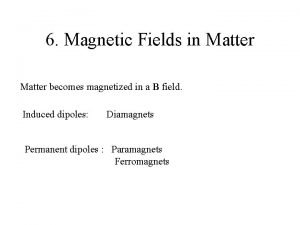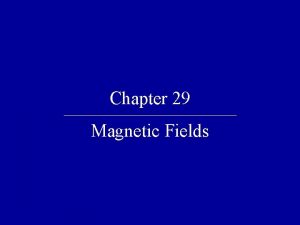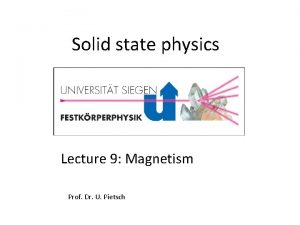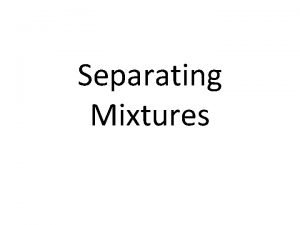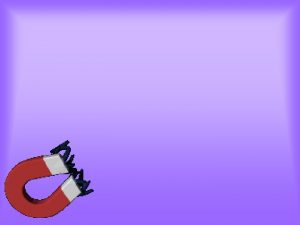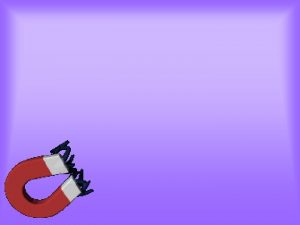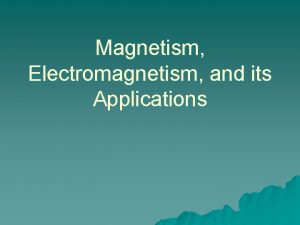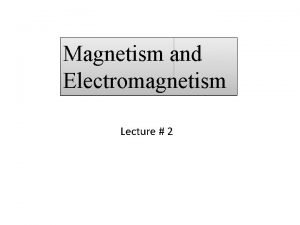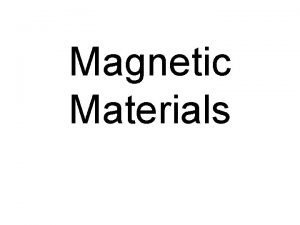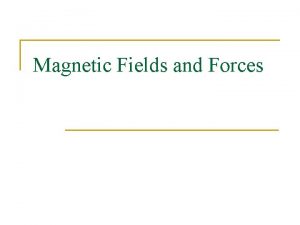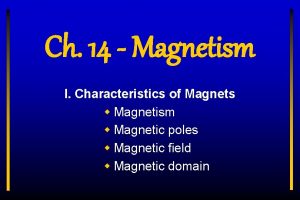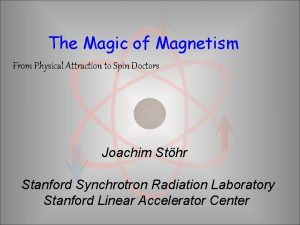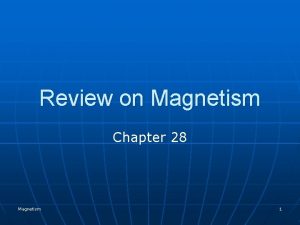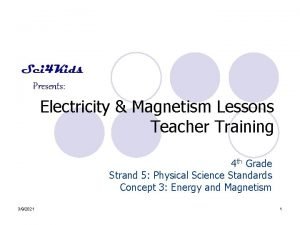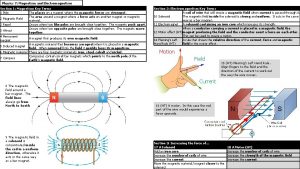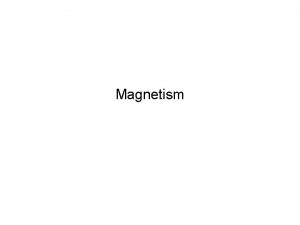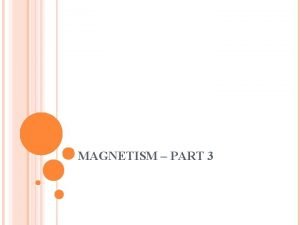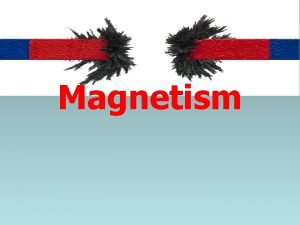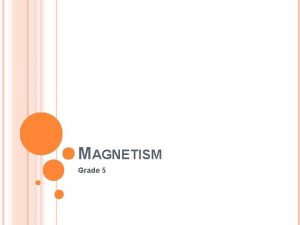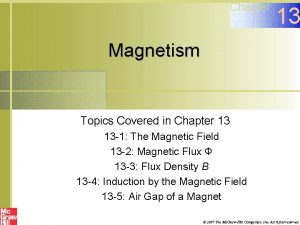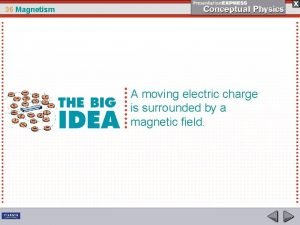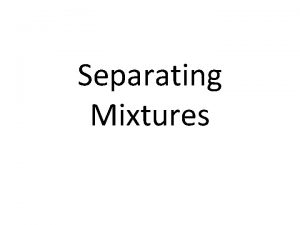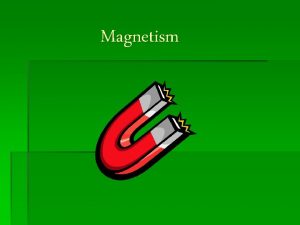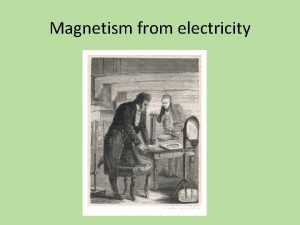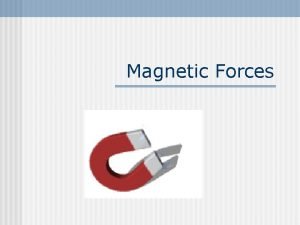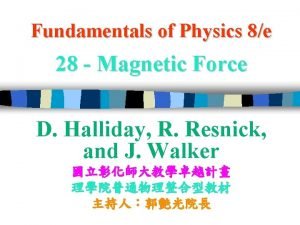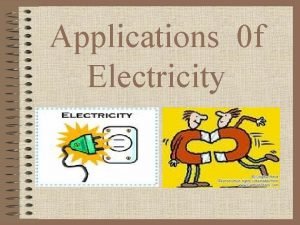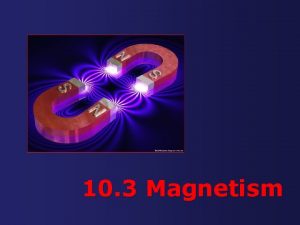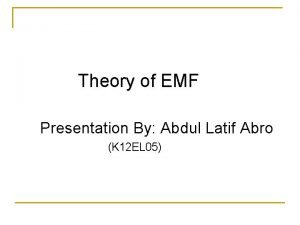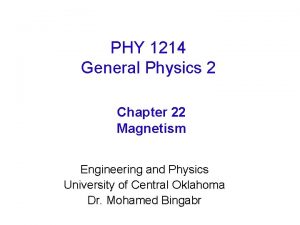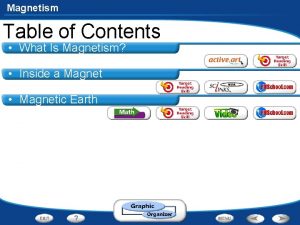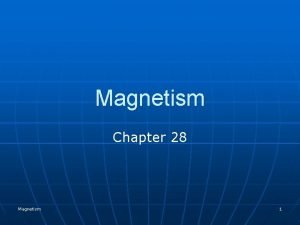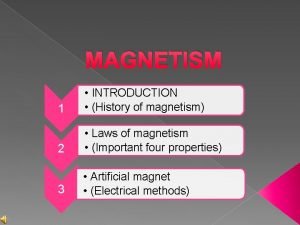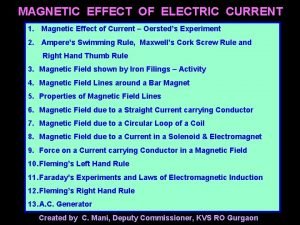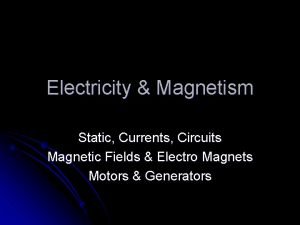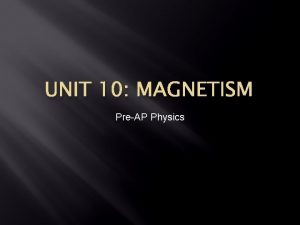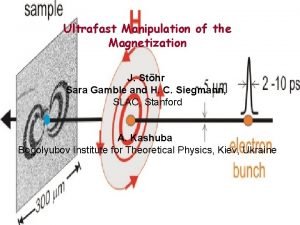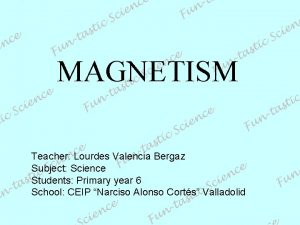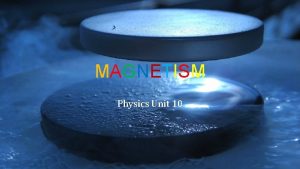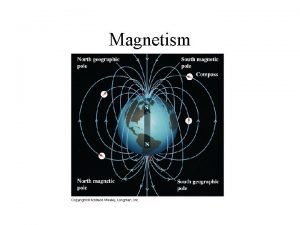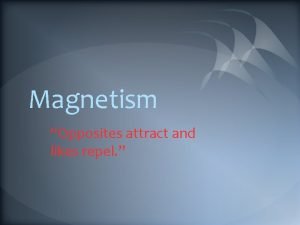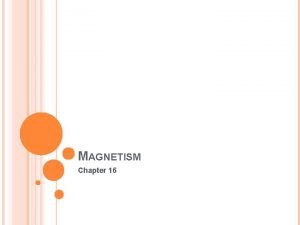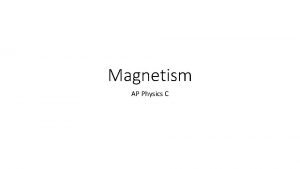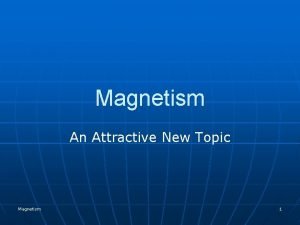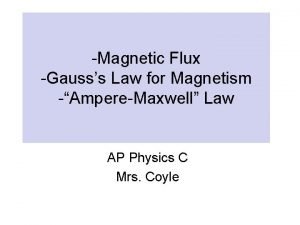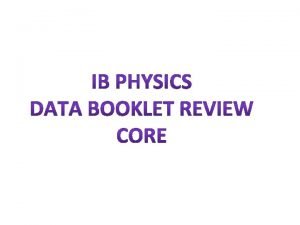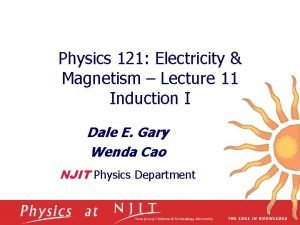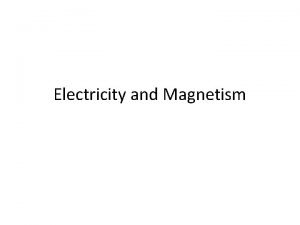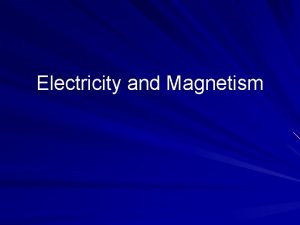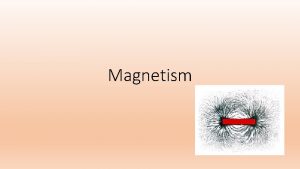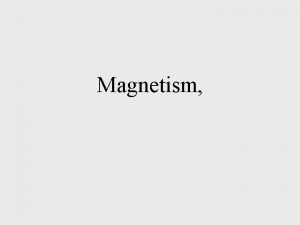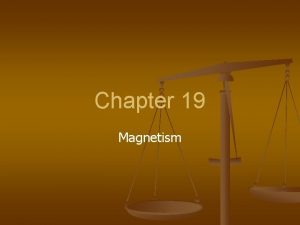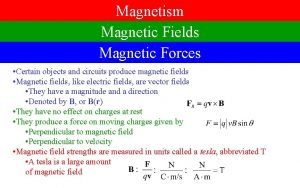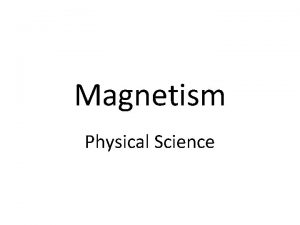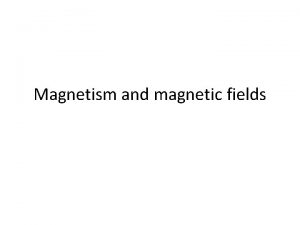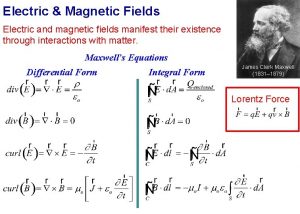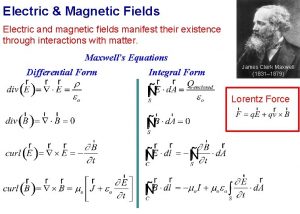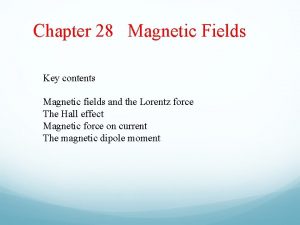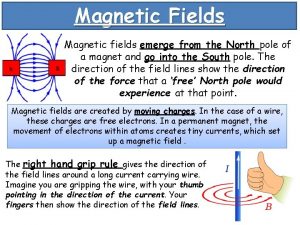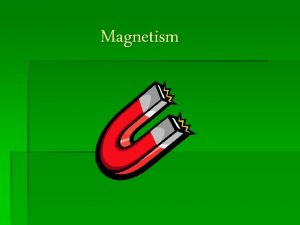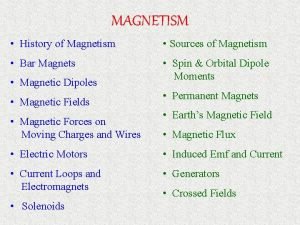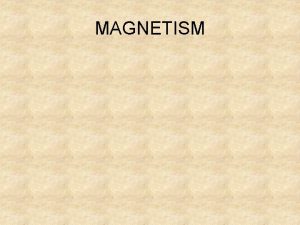Magnetic Fields Magnetism on the Atomic Level Magnetic

















































































- Slides: 81

Magnetic Fields

Magnetism on the Atomic Level

Magnetic Domains

Magnetic Poles

Magnetic Fields and the Definition of B The Field. We can define a magnetic field B to be a vector quantity that exists when it exerts a force FB on a charge moving with velocity v. We can next measure the magnitude of FB when v is directed perpendicular to that force and then define the magnitude of B in terms of that force magnitude: where q is the charge of the particle. We can summarize all these results with the following vector equation: that is, the force FB on the particle by the field B is equal to the charge q times the cross product of its velocity v and the field B (all measured in the same reference frame). We can write the magnitude of FB as where ϕ is the angle between the directions of velocity v and magnetic field B.

Force on a Moving Charge + charge + - charge –

Magnetic Fields and the Definition of B This equation tells us the direction of F. We know the cross product of v and B is a vector that is perpendicular to these two vectors. The right-hand rule (Figs. a-c) tells us that the thumb of the right hand points in the direction of v × B when the fingers sweep v into B. If q is positive, then (by the above Eq. ) the force FB has the same sign as v × B and thus must be in the same direction; that is, for positive q, FB is directed along the thumb (Fig. d). If q is negative, then the force FB and cross product v × B have opposite signs and thus must be in opposite directions. For negative q, F is directed opposite thumb (Fig. e).

Magnetic Fields and the Definition of B Answer: (a) towards the positive z-axis (b) towards the negative x-axis (c) none (cross product is zero)

Magnetic Fields and the Definition of B

Concept Check – Magnetic Force (2) A positive charge enters a uniform magnetic field as shown. What is the direction of the magnetic force? 1. out of the page 2. into the page 3. downward 4. upward 5. to the left x x x x x vx x q x x x

Concept Check – Magnetic Force (2) A positive charge enters a uniform magnetic field as shown. What is the direction of the magnetic force? 1. out of the page 2. into the page 3. downward 4. upward 5. to the left x x x F x x vx q x x x x Using the right-hand rule, you can see that the magnetic force is directed upward Remember that the magnetic force must be perpendicular to BOTH the B field and the velocity

Concept Check – Magnetic Force (3) A positive charge enters a uniform magnetic field as shown. What is the direction of the magnetic force? 1. out of the page 2. into the page 3. downward 4. upward 5. to the left ®®®®® v ®®®®® q ®®®®®

Concept Check – Magnetic Force (3) A positive charge enters a uniform magnetic field as shown. What is the direction of the magnetic force? 1. out of the page 2. into the page 3. downward 4. upward 5. to the left ®®®®® v ®®®®® F ´ q ®®®®® Using the right-hand rule, you can see that the magnetic force is directed into the page Remember that the magnetic force must be perpendicular to BOTH the B field and the velocity

Concept Check – Magnetic Force (4) A positive charge enters a uniform magnetic field as shown. What is the direction of the magnetic force? 1. out of the page 2. into the page 3. zero 4. to the right 5. to the left v q

Concept Check – Magnetic Force (4) A positive charge enters a uniform magnetic field as shown. What is the direction of the magnetic force? 1. out of the page 2. into the page 3. zero 4. to the right 5. to the left v q F = 0 The charge is moving parallel to the magnetic field, field so it does not experience any magnetic force Remember that the magnetic force is given by: F = q v B sin(q). What is q for this scenario?

Concept Check – Atom Beam A beam of atoms enters a magnetic field region. What path will the atoms follow? 1 x x x x x x x x x 2 x x x x x x 4 x x x 3

Concept Check – Atom Beam A beam of atoms enters a magnetic field region. What path will the atoms follow? 1 x x x x x x x x x 2 x x x x x x 4 3 x x x Atoms are neutral objects whose net charge is zero Thus they do not experience a magnetic force. Follow-up: What charge would follow path 3? What about path 1?

Concept Check – Force on Charge in Magnetic Field A proton beam enters into a magnetic field region as shown below. What is the direction of the magnetic field B? 1. + y 2. – y 3. + x 4. + z (out of page) 5. – z (into page) y x

Concept Check – Force on Charge in Magnetic Field A proton beam enters into a magnetic field region as shown below. What is the direction of the magnetic field B? 1. + y 2. – y 3. + x 4. + z (out of page) 5. – z (into page) y x The picture shows the force acting in the +y direction Applying the right-hand rule leads to a B field that points into the page The B field must be into the plane because B v and B F. F

Magnetic Fields and the Definition of B Magnetic Field Lines We can represent magnetic fields with field lines, as we did for electric fields. Similar rules apply: (1) the direction of the tangent to a magnetic field line at any point gives the direction of B at that point (2) the spacing of the lines represents the magnitude of B —the magnetic field is stronger where the lines are closer together, and conversely. Two Poles. The (closed) field lines enter one end of a magnet and exit the other end. The end of a magnet from which the field lines emerge is called the north pole of the magnet; the other end, where field lines enter the magnet, is called the south pole. Because a magnet has two poles, it is said to be a magnetic dipole.

Magnetic Fields and the Definition of B (a) The magnetic field lines for a bar magnet. (b) A “cow magnet” — a bar magnet that is intended to be slipped down into the rumen of a cow to recover accidentally ingested bits of scrap iron and to prevent them from reaching the cow’s intestines. The iron filings at its ends reveal the magnetic field lines.

Sample 28. 01

Magnetic Fields

Magnetic Fields Bar Magnet The direction of a magnetic field can be seen by placing a compass near a bar magnet. The North pole of the compass points in the direction of the field, away from North and toward South. The magnetic field can also be seen by placing the magnet under a piece of paper and sprinkling small iron filings on top. The filings line up in the shape of the field, as shown at right.

Magnetic Fields

Magnetic Field of Earth Spin axis The geographic North Pole is a magnetic south pole. The North pole of a compass points to the Earth's geographic North Pole, which means that there must be a magnetic South Pole up there.

Magnetic Field of Earth

Van Allen Belts

Van Allen Belts

Aurora Over Alaska

Aurora Over Prelude Lake, Canada

Aurora and Meteor Over Norway

Above Aurora Australis

Northern Lights Over Canada

Aurora Over Alaska

Aurora in West Texas Skies

Aurora Over Missouri, Oct. 24, 2011

Aurora Over Arkansas, Oct. 24, 2011

Concept Check – Moving in a Magnetic Field In what direction would a B field have to point for a beam of electrons moving to the right to go undeflected through a region where there is a uniform electric field pointing vertically upward? E 1. up (parallel to E ) 2. down (antiparallel to E ) 3. into the page 4. out of the page 5. impossible to accomplish B=? electrons v

Concept Check – Moving in a Magnetic Field In what direction would a B field have to point for a beam of electrons moving to the right to go undeflected through a region where there is a uniform electric field pointing vertically upward? E 1. up (parallel to E ) 2. down (antiparallel to E ) 3. into the page 4. out of the page 5. impossible to accomplish B=? electrons v Without a B field, the electrons feel an electric force downward In order to compensate, the magnetic force has to point upward Using the right-hand rule and the fact that the electrons are negatively charged leads to a B field pointing out of the page

Crossed Fields: Discovery of The Electron A modern version of J. J. Thomson’s apparatus for measuring the ratio of mass to charge for the electron. An electric field E is established by connecting a battery across the deflecting-plate terminals. The magnetic field B is set up by means of a current in a system of coils (not shown). The magnetic field shown is into the plane of the figure, as represented by the array of Xs (which resemble the feathered ends of arrows). If a charged particle moves through a region containing both an electric field and a magnetic field, it can be affected by both an electric force and a magnetic force. When the two fields are perpendicular to each other, they are said to be crossed fields. If the forces are in opposite directions, one particular speed will result in no deflection of the particle.

Crossed Fields: Discovery of The Electron

Crossed Fields: The Hall Effect As we just discussed, a beam of electrons in a vacuum can be deflected by ad magnetic field. Can the drifting conduction electrons in a copper wire also be deflected by a magnetic field? In 1879, Edwin H. Hall, then a 24 -year-old graduate student at the Johns Hopkins University, showed that they can. This Hall effect allows us to find out whether the charge carriers in a conductor are positively or negatively charged. Beyond that, we can measure the number of such carriers per unit volume of the conductor. Figure (a) shows a copper strip of width d, carrying a current i whose conventional direction is from the top of the figure to the bottom. The charge carriers are electrons and, as we know, they drift (with drift speed vd) in the opposite direction, from bottom to top. As time goes on, electrons move to the right, mostly piling up on the right edge of the strip, leaving uncompensated positive charges in fixed positions at the left edge as shown in figure (b).

Crossed Fields: The Hall Effect When a uniform magnetic field B is applied to a conducting strip carrying current i, with the field perpendicular to the direction of the current, a Hall-effect potential difference V is set up across the strip. The electric force FE on the charge carriers is then balanced by the magnetic force FB on them. The number density n of the charge carriers can then be determined from in which l (= A/d) is the thickness of the strip. With this equation we can find n from measurable quantities.

Crossed Fields: The Hall Effect Moving Conductor When a conductor moves through a uniform magnetic field B at speed v, the electrons in the conductor also move as a result. The conduction electrons will experience a force causing them to move and set up an E-field and potential difference, V. Equilibrium will be established and the Halleffect potential difference V across it is Where d is the width perpendicular to both velocity v and field B.

Sample 28. 02

Sample 28. 02

A Circulating Charged Particle A beam of electrons is projected into a chamber by an electron gun G. The electrons enter in the plane of the page with speed v and then move in a region of uniform magnetic field B directed out of that plane. As a result, a magnetic force FB= q (v×B) continuously deflects the electrons, and because v and B are always perpendicular to each other, this deflection causes the electrons to follow a circular path. The path is visible in the photo because atoms of gas in the chamber emit light when some of the circulating electrons collide with them.

A Circulating Charged Particle

A Circulating Charged Particle The quantities T, f, and do not depend on the speed of the particle. Fast particles move in large circles and slow ones in small circles, but particles with the same charge to mass ratio take the same time T to complete one round trip. You can also see, according to the right hand rule, that the direction of rotation for a positive particle is ccw when looking in the direction of B.

Concept Check – Mass Spectrometer Two particles of the same speed and charge enter a magnetic field and follow the paths shown. Which particle has the bigger mass? 3. both masses are equal 4. impossible to tell from the picture x x x x x x x x x x x x x x x x x x 1 2

Concept Check – Mass Spectrometer Two particles of the same speed and charge enter a magnetic field and follow the paths shown. Which particle has the bigger mass? 3. both masses are equal 4. impossible to tell from the picture x x x x x x x x x The relevant equation for us is: x x x x x x x x x 1 2 According to this equation, the bigger the mass, the larger the radius. Follow-up: This is one way to separate isotopes.

Concept Check – Mass Spectrometer Two particles of the same mass and speed enter a magnetic field and follow the paths shown. Which particle has the bigger charge? 3. both charges are equal 4. impossible to tell from the picture x x x x x x x x x x x x x x x x x x 1 2

Concept Check – Mass Spectrometer Two particles of the same mass and speed enter a magnetic field and follow the paths shown. Which particle has the bigger charge? 3. both charges are equal 4. impossible to tell from the picture x x x x x x x x x x x x The relevant equation for us is: x x x x x x 1 2 According to this equation, the bigger the charge, the smaller the radius. Follow-up: What is the sign of the charges in the picture?

Concept Check – Mass Spectrometer (2) A proton enters a uniform magnetic field that is perpendicular to the proton’s velocity. What happens to the kinetic energy of the proton? 1. it increases 2. it decreases 3. it stays the same 4. depends on the velocity direction 5. depends on the B field direction x x x x x x x x x x x x x x x

Concept Check – Mass Spectrometer (2) A proton enters a uniform magnetic field that is perpendicular to the proton’s velocity. What happens to the kinetic energy of the proton? 1. it increases 2. it decreases 3. it stays the same 4. depends on the velocity direction 5. depends on the B field direction x x x x x x x x x x x x x x x The velocity of the proton changes direction but the magnitude (speed) doesn’t change. Thus the kinetic energy stays the same

Helical Paths

Helical Paths

Sample 28. 03

Sample 28. 04

Cyclotrons and Synchrotrons The Cyclotron: The figure is a top view of the region of a cyclotron in which the particles (protons, say) circulate. The two hollow Dshaped objects (each open on its straight edge) are made of sheet copper. These dees, as they are called, are part of an electrical oscillator that alternates the electric potential difference across the gap between the dees. The electrical signs of the dees are alternated so that the electric field in the gap alternates in direction, first toward one dee and then toward the other dee, back and forth. The dees are immersed in a large magnetic field directed out of the plane of the page. The magnitude B of this field is set via a control on the electromagnet producing the field. The key to the operation of the cyclotron is that the frequency f at which the proton circulates in the magnetic field (and that does not depend on its speed) must be equal to the fixed frequency fosc of the electrical oscillator, or This resonance condition says that, if the energy of the circulating proton is to increase, energy must be fed to it at a frequency fosc that is equal to the natural frequency f at which the proton circulates in the magnetic field.

Cyclotron

Cyclotron

Cyclotrons and Synchrotrons Proton Synchrotron: The magnetic field B and the oscillator frequency fosc, instead of having fixed values as in the conventional cyclotron, are made to vary with time during the accelerating cycle. When this is done properly, (1) the frequency of the circulating protons remains in step with the oscillator at all times, and (2) the protons follow a circular — not a spiral — path. Thus, the magnet need extend only along that circular path, not over some 4 ✕ 106 m 2. The circular path, however, still must be large if high energies are to be achieved.

Fermi National Accelerator Laboratory Photo Tour of Fermilab

Magnetic Force on Current-Carrying Wire A straight wire carrying a current i in a uniform magnetic field experiences a sideways force Here L is a length vector that has magnitude L and is directed along the wire segment in the direction of the (conventional) current. Crooked Wire. If a wire is not straight or the field is not uniform, we can imagine the wire broken up into small straight segments. The force on the wire as a whole is then the vector sum of all the A flexible wire passes between the forces on the segments that make it up. In the pole faces of a magnet (only the farther pole face is shown). (a) differential limit, we can write and the direction of length vector L or d. L is in the direction of i. Without current in the wire, the wire is straight. (b) With upward current, the wire is deflected rightward. (c) With downward current, the deflection is leftward.

Forces on Wires

Concept Check – Magnetic Force on a Wire A vertical wire carries a current and is in a vertical magnetic field. What is the direction of the force on the wire? 1. left 2. right 3. zero 4. into the page 5. out of the page I B

Concept Check – Magnetic Force on a Wire A vertical wire carries a current and is in a vertical magnetic field. What is the direction of the force on the wire? 1. left 2. right 3. zero 4. into the page 5. out of the page I B When the current is parallel to the magnetic field lines, the force on the wire is zero

Concept Check – Magnetic Force on a Wire (2) A horizontal wire carries a current and is in a vertical magnetic field. What is the direction of the force on the wire? 1. left 2. right 3. zero 4. into the page 5. out of the page I B

Concept Check – Magnetic Force on a Wire (2) A horizontal wire carries a current and is in a vertical magnetic field. What is the direction of the force on the wire? 1. left 2. right 3. zero 4. into the page 5. out of the page I B Using the right-hand rule for charge moving in a magnetic field, we see that the magnetic force must point out of the page Since F must be perpendicular to both I and B, you should realize that F cannot be in the plane of the page at all

Sample 28. 06

Torque on a Current Loop As shown in the figure (right) the net force on the loop is the vector sum of the forces acting on its four sides and comes out to be zero. The net torque acting on the coil has a magnitude given by where N is the number of turns in the coil, A is the area of each turn, i is the current, B is the field magnitude, and θ is the angle between the magnetic field B and the normal vector to the coil n. The elements of an electric motor: A rectangular loop of wire, carrying a current and free to rotate about a fixed axis, is placed in a magnetic field. Magnetic forces on the wire produce a torque that rotates it. A commutator (not shown) reverses the direction of the current every half-revolution so that the torque always acts in the same direction.

Concept Check – Magnetic Force on a Loop A rectangular current loop is in a uniform magnetic field. What is the direction of the net force on the loop? 1. + x 2. + y 3. zero 4. - x 5. - y B z y x

Concept Check – Magnetic Force on a Loop A rectangular current loop is in a uniform magnetic field. What is the direction of the net force on the loop? 1. + x 2. + y 3. zero 4. - x 5. - y B z y x Using the right-hand rule, we find that each of the four wire segments will experience a force outward from the center of the loop. Thus, the forces of the opposing segments cancel, so the net force is zero

Concept Check – Magnetic Force on a Loop (2) If there is a current in the loop in the direction shown, the loop will: 1. move up 2. move down 3. rotate clockwise 4. rotate counterclockwise 5. both rotate and move N S

Concept Check – Magnetic Force on a Loop (2) If there is a current in the loop in the direction shown, the loop will: 1. move up 2. move down 3. rotate clockwise 4. rotate counterclockwise 5. both rotate and move N S Look at the North Pole: here the magnetic field points to the right and the current points out of the page The right-hand rule says that the force must point up. up At the south pole, the same logic leads to a downward force. Thus the loop rotates clockwise

Torque on a Current Loop

Torque on a Current Loop

Summary The Magnetic Field B • Defined in terms of the force FB acting on a test particle with charge q moving through the field with velocity v Eq. 28 -2 A Charge Particle Circulating in a Magnetic Field • Applying Newton’s second law to the circular motion yields Eq. 28 -15 • from which we find the radius r of the orbit circle to be Eq. 28 -16 Magnetic Force on a Current Carrying wire • A straight wire carrying a current i in a uniform magnetic field experiences a sideways force Eq. 28 -26 • The force acting on a current element i d. L in a magnetic field is Eq. 28 -28 Torque on a Current Carrying Coil • A coil (of area A and N turns, carrying current i) in a uniform magnetic field B will experience a torque τ given by Eq. 28 -37

Summary The Hall Effect • When a conducting strip carrying a current i is placed in a uniform magnetic field B, some charge carriers (with charge e) build up on one side of the conductor, creating a potential difference V across the strip. The polarities of the sides indicate the sign of the charge carriers. Orientation Energy of a Magnetic Dipole • The orientation energy of a magnetic dipole in a magnetic field is Eq. 28 -38 • If an external agent rotates a magnetic dipole from an initial orientation θi to some other orientation θf and the dipole is stationary both initially and finally, the work Wa done on the dipole by the agent is Eq. 28 -39
 Red fields
Red fields Vertical magnetic field
Vertical magnetic field Conceptual physics magnetism
Conceptual physics magnetism Learning: module 26: magnetic forces and fields
Learning: module 26: magnetic forces and fields Scrap heap magnet circuit diagram
Scrap heap magnet circuit diagram Magnetic fields in matter
Magnetic fields in matter Magnetic force quiz
Magnetic force quiz Electric currents and magnetic fields
Electric currents and magnetic fields Visualizing magnetic field
Visualizing magnetic field Relative atomic mass of beryllium
Relative atomic mass of beryllium Period trends
Period trends Atom radius
Atom radius How to calculate abundance in isotopes
How to calculate abundance in isotopes Atomic
Atomic Atomic number vs atomic radius
Atomic number vs atomic radius Magnetic retentivity
Magnetic retentivity Magnetic flux weber
Magnetic flux weber Magnetic moment and magnetic field relation
Magnetic moment and magnetic field relation Magnetic force particle
Magnetic force particle Physics 102 electricity and magnetism
Physics 102 electricity and magnetism Ib physics topic 5 question bank
Ib physics topic 5 question bank Aaron ahuvia
Aaron ahuvia Magnetism in solid state physics
Magnetism in solid state physics Example of magnetism in separating mixtures
Example of magnetism in separating mixtures Magnetism
Magnetism Aportaciones de hans christian oersted
Aportaciones de hans christian oersted It is an invisible force
It is an invisible force Magnetism is an invisible
Magnetism is an invisible Magnetism and electromagnetism
Magnetism and electromagnetism Artificial magnet example
Artificial magnet example Electromagnetic particle inspection
Electromagnetic particle inspection Hysteresis loop
Hysteresis loop Magnetismn
Magnetismn Current equation
Current equation Magnetism test review
Magnetism test review Electricity jeopardy
Electricity jeopardy 14 characteristics of magnetism
14 characteristics of magnetism Joachim stöhr
Joachim stöhr Sph3u electricity and magnetism
Sph3u electricity and magnetism Magnetism
Magnetism Basics of magnetism
Basics of magnetism Magnetism and electromagnetism
Magnetism and electromagnetism Electromagnet experiment hypothesis
Electromagnet experiment hypothesis The phenomenon of magnetism is best understood in terms of
The phenomenon of magnetism is best understood in terms of Magnetism
Magnetism Qvbsin theta
Qvbsin theta Magnetic susceptibility formula
Magnetic susceptibility formula Grade 5 electricity and magnetism
Grade 5 electricity and magnetism Hysteresis loop for magnetic material
Hysteresis loop for magnetic material Magnetism
Magnetism Magnetism
Magnetism Example of magnetism in separating mixtures
Example of magnetism in separating mixtures Characteristics of magnetism
Characteristics of magnetism Electricity and magnetism
Electricity and magnetism Right hand grip rule
Right hand grip rule Magnetohydrodynamics
Magnetohydrodynamics Types of magnetism
Types of magnetism Electricity and magnetism
Electricity and magnetism Electricity and magnetism
Electricity and magnetism Magnetism eu
Magnetism eu Influens magnetism
Influens magnetism Abro orientation
Abro orientation General physics
General physics What is this picture
What is this picture Magnetism
Magnetism Magnetism
Magnetism Snow rule in magnetism
Snow rule in magnetism Magnetism
Magnetism Neofer magnet
Neofer magnet Preap magnetism 1
Preap magnetism 1 Ultrafast magnetism
Ultrafast magnetism Electric field and magnetic field difference
Electric field and magnetic field difference Magnetism examples
Magnetism examples Magnetism
Magnetism Vad är en permanentmagnet
Vad är en permanentmagnet Magnets opposites attract
Magnets opposites attract What is magnet and magnetism
What is magnet and magnetism Magnetism
Magnetism Magnetism
Magnetism Gauss law of magnetism
Gauss law of magnetism Electricity and magnetism
Electricity and magnetism Electricity and magnetism
Electricity and magnetism





